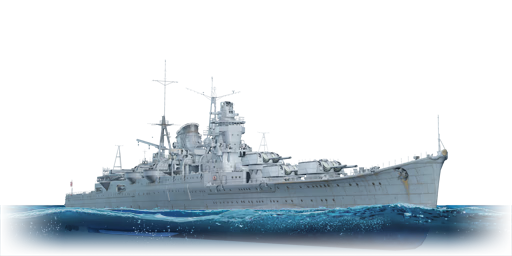Mogami (最上, namesake: Mogami River) was a Japanese heavy cruiser commissioned in July 1935. Sea trials discovered huge instability in her hull, which forced refitting with large hull bulges. In 1940, she participated in the occupation of French Southeast Asia with her sister ship Mikuma, and after the Pearl Harbour attacks in December 1941, she covered the invasion of British Borneo. There, along with Mikuma and escorting destroyers, they destroyed the cruisers USS Houston and HMAS Perth. In June 1942, during the Battle of Midway, Mogami collided with Mikuma due to communication errors. While attempting to withdraw, she was attacked by numerous American aircraft, leading to Mikuma's sinking and Mogami's return to port for repairs. During this refit, she was converted into an aircraft-carrying cruiser with a flight deck for seaplanes and enhanced anti-aircraft armament.
In June 1944, she participated in operations in the Philippines but retired after the loss of Japanese air superiority. In October 1944, during the Battle of Leyte Gulf, she was engaged by American forces, suffered damage from USS Portland, collided with the Japanese cruiser Nachi resulting in fires and explosions that disabled her engines, and was further disabled by American cruisers and aircraft. An order was given to abandon ship, after which her empty husk remained afloat for several hours until she sank. Her wreck was located in 2019 by R/V Petrel, 1,450 m below the surface.
Introduced in Update 1.91 "Night Vision" in her 1940 configuration, Mogami is most notable for replacing the 155 mm primary guns of her sister ships with the 203 mm guns known from vessels such as Tone. Similarly to her sisters, she is a very capable cruiser with decent survivability, good mobility, outstanding torpedo armament, and two modernised floatplanes that can help with winning games through capturing points. Overall, she is an interesting alternative to Suzuya, with the choice of main guns largely coming down to personal preference, as the 203 mm guns still don't address the biggest issue of all the heavy cruisers in such a high BR - inability to effectively counter battleships.














